Table of contents
The term honeydew melon is ambiguous (see text). It usually refers to the commercial type of honeydew melon or winter melon ( Cucumis melo var. inodorus ), but it can also refer specifically to the oval-shaped sugar melon with a bright yellow skin, under which light, often slightly greenish flesh is hidden (yellow canary).
Use in the kitchen
Honeydew melons are popular in many recipes because of their honey-sweet flesh. Under the thick whitish or yellow skin, only a slightly sweet smell comes through, not comparable to the aromatic scent of a ripe cantaloupe melon .
How do you cut a honeydew melon? Depending on how you want to use it, you can cut the washed, whole melon in half, remove the seeds with a spoon and then cut it into wedges or pieces (with the peel). You can also peel the whole melon first. Figures or balls cut out of the flesh are suitable as edible decorations.
Fresh honeydew melon pieces are perfect as a dessert or raw finger food, a little lemon juice adds a good acidity. Chopped up, raw honeydew melons also taste good in muesli, fruit salad, punch or in a glass as a vegan layered dessert. Raw honeydew melons can be used to make delicious vegan sorbets, smoothies, cocktails and shakes. Vegan melon lassi can be prepared with vegan yoghurt ( soy yoghurt ) and a plant-based drink (e.g. oat milk ).
The yellow honeydew melon or yellow canary melon (but also other varieties) can be baked in cakes, tarts and gateaux or halved and baked in the oven.
The intense sweetness of ripe honeydew melons gives spicy salads an exotic touch. Steamed vegetables such as sweet peppers ( red and yellow ) and zucchini with raw honeydew melon make a quick dish. For mild barbecue evenings, honeydew melon is an excellent vegan alternative to prepare on the grill. Cut the melon into 2 cm thick slices and grill it plain or seasoned with salt ,pepper , nutmeg or curry powder . A diced honeydew melon with other grilled vegetables on skewers adds a sweet and sour touch.
The best way to preserve leftover melon pieces is to make a spicy chutney with white wine vinegar or a sweet chutney with sugar . Boiled melon juice, i.e. syrup, is good for sweetening and refining creams.
Vegan recipe for honeydew melon and tomato gazpacho
Ingredients (for 4 people): 1 honeydew melon (approx. 1 kg, raw, organic), 2 pointed peppers, 250 g tomatoes , 1 cucumber (optionally peeled or seeded), 15 g fresh ginger , 8 sprigs of mint , 1 onion , 1 clove of garlic , 10 g pine nuts (unroasted), possibly 1 tbsp rapeseed oil .
Preparation: Halve the melon, remove the seeds, cut the flesh into small pieces. If the cucumber has a thick skin and/or particularly large seeds, you can peel or remove the seeds. Dice the pointed peppers (without seeds), tomatoes and cucumber. Peel the raw ginger and cut into fine cubes. Pluck the mint leaves from seven stalks, put them in a blender together with the melon pieces, pointed peppers, tomatoes, cucumber and ginger and puree. Dice the onion and garlic very finely and fold into the mixture. Cover and chill in the fridge for at least 2 hours. Serve the cold melon and tomato gazpacho in bowls or deep plates. Garnish the vegan gazpacho (drizzle with oil) with plucked mint leaves and pine nuts and serve.
Vegan honeydew melon recipes can be found under the note: " Recipes that have the most of this ingredient ".
| Not only vegans or vegetarians should read this: Vegans often eat unhealthily. Avoidable nutritional mistakes . |
Purchasing - Storage
Honeydew melons, predominantly the Yellow Canary, can be found in most supermarket chains such as Coop , Migros , Denner , Volg , Spar , Aldi , Lidl , Rewe , Billa , Edeka or Hofer , occasionally also in controlled organic quality (organic quality). Honeydew melons can also be bought in organic supermarkets such as Denn's Biomarkt or Alnatura , as well as seasonally at the weekly market. In Central Europe, honeydew melons are available all year round; the European harvest has its peak season in stores from June to September . 1
When is a honeydew melon ripe? When fully ripe, the oval yellow honeydew melon has a bright yellow skin all around and exudes a slightly sweet scent, especially at the base of the stem. If you gently press on the outer skin, it gives way slightly as soon as the honeydew melon is ripe. Since a honeydew melon does not ripen, you should pay attention to the desired degree of ripeness when buying it. 2.20
The group of honeydew melons looks a little different: many varieties have a white-gray skin, greenish flesh and are not perfumed even when fully ripe (green honeydew). The orange-fleshed varieties (orange honeydew) smell slightly when fully ripe, but last for a shorter time than the former. 18
The availability of honeydew melons varies depending on the size of the store, catchment area, etc. If you are interested, click on our recorded food prices for the DA-CH countries (above under the ingredient image). There you will find current prices from various supermarkets and their price development.
Storage tips
A honeydew melon has a rather robust skin and does not ripen further: therefore, the intact fruit can be stored for one to two weeks without any problem. By storing it for a long time, you can achieve a pleasantly soft consistency, but the sugar content of the honeydew melon does not change. When is a honeydew melon bad? If it gives off a penetratingly sweet smell, a honeydew melon is overripe and no longer edible. Cut melons should be stored in the refrigerator covered with cling film and eaten within a few days, as they spoil quickly.
The low-acid flesh of melons provides a good breeding ground for harmful microorganisms such as salmonella, listeria or EHEC. When cutting, the pathogens get onto the flesh from the (unwashed) peel or via contaminated hands or kitchen utensils (knife, cutting board). You can prevent infections with good kitchen hygiene. Pre-cut melon pieces should be eaten quickly or refrigerated. The Federal Institute for Risk Assessment ( BfR ) recommends that melons should be thrown away if they are stored unrefrigerated for several hours. 3
Ingredients - Nutritional values - Calories
Does a honeydew melon have a lot of calories? A raw honeydew melon has around 36 kcal/100g and contains a lot of juicy flesh, which is 90% water . The proportion of carbohydrates (9.1 g/100g) is low. Does the honeydew melon contain fructose? With a sugar content of around 8.1 g/100g, the fructose content is around 2.96 g/100g, the rest consists mainly of sucrose and glucose. 4 The values can vary depending on the growing conditions and variety.
With 0.14 g fat and 0.54 g protein per 100 g, a honeydew melon is almost fat-free and very low in protein. The 0.8 g of fiber covers 3.2% of the daily requirement. 4
A raw honeydew melon contains 18 mg of vitamin C per 100 g, which is 23% of the daily requirement. Zucchini (18 mg/100g) and soursop (19 mg/100g) have comparable amounts. Guava contains a lot of ascorbic acid, at 228 mg/100g. 4
Potassium is contained in a honeydew melon at 228 mg/100g (11% of the daily requirement). Cherries (222 mg/100g) and figs (232 mg/100g) have a similar amount of potassium. A fruit with almost twice as much potassium is the raw jackfruit (448 mg/100g). 4
The folic acid content is 19 µg/100g (10% of the daily requirement); it is comparable to that of pineapple (18 µg/100g) and kumquat (17 µg/100g). A real guava has significantly more at 49 µg/100g, but 100 g still only cover 25% of the daily requirement. 4
The complete ingredients of honeydew melon, the coverage of the daily requirement and comparison values with other ingredients can be found in our nutrient tables. In the article Nutrients explained you will get a detailed insight into the topic.
Health effects
High blood pressure (hypertension) is one of the best-known risk factors for cardiovascular disease and stroke, so eating honeydew melons can have a blood pressure-lowering effect due to the potassium they contain. 5
Cantaloupe juice has an alkalizing effect on urine, which promotes the dissolution and excretion of urinary stones. Melon juice can therefore serve as an alternative preventive measure to potassium citrate medications. 7 This alkalizing effect on urine can help prevent urinary tract diseases. 8
Secondary plant substances
Many of the health effects of honeydew melons can be attributed to the secondary plant substances they contain. Our article on secondary plant substances provides an overview of the classification of substance groups, their occurrence in foods and possible effects on humans.
Since the name "honeydew melon" is often not used consistently, it can refer to different looking melon varieties (see the "Further information" chapter). The term "honeydew melon" is often used synonymously for the superordinate group of "sugar melons". Therefore, in addition to the secondary plant substances of the "honeydew melon" variety, we also describe those of the supergroup "sugar melons".
Sugar melons (honey melons) contain the following secondary plant substances: 22,23,24,25
- Isoprenoids: Carotenoids: Beta-carotene; Saponins; Terpenoids: Apocarotenoids (Beta-cyclocitral); Terpenes: Triterpenes (Curcurbitacin, Phytosterols), Monoterpenes (Oleuropein, Limonene, Eucalyptol); Sesquiterpenes (Beta-Caryophyllene); Diterpenes (Phytol)
- Alkaloids
- Polyphenols: Phytoestrogens: beta-estradiol, isoflavones; Flavonoids: flavonols (rutin), flavones (luteolin, apigenin, amentoflavone); Phenolic acids: gallic acid, protocatechuic acid, chlorogenic acid, 4-hydroxybenzoic acid, 3-hydroxybenzoic acid, isovanillic acid, p-coumaric acid, m-coumaric acid, hydroxytyrosol
- Organic sulphur-containing compounds
However, it should be noted that the composition of secondary plant substances in honeydew melons can vary depending on the variety, time of harvest and growing conditions. Therefore, quantities are only of limited use and should only be understood roughly.
Studies on the secondary plant compounds in muskmelon show that Cucumis melo is a promising source of natural antioxidants. This makes it a therapeutic agent for the prevention of oxidative stress and related diseases. The positive effect is due to the synergistic interaction of various secondary plant compounds contained in the fruit. 23
Extracted cucurbitacins from Cucumis melo have a blood pressure lowering effect because they improve blood vessel tension. The results of an animal study from China show a possibility to increase the effectiveness of clinical drugs for the treatment of high blood pressure. 6
An in vitro study analyzing the components of the fruit and seeds of the muskmelon has also shown that the bioactive compounds contained therein can inhibit the growth of various types of cancer cells. However, further research is needed to identify additional secondary plant substances from muskmelon and to investigate their pharmacological significance in more detail. 24
The components of the cantaloupe also show positive effects on the digestive tract. In an animal study with rats, it was investigated whether the administration of a melon extract could alleviate existing insulin resistance. It was found that the phytochemicals contained can inhibit inflammation in the intestine, which can improve insulin resistance. It also led to changes in the composition of the intestinal bacteria, which had a positive effect on the health of the digestive tract and led to improved control of blood sugar levels. These results suggest that Cucumis melo could be a potential means of preventing insulin resistance and diabetes, two inflammation-related metabolic diseases. 26
Dangers - Intolerances - Side effects
If the temperature is too high, harmful microorganisms can multiply on cut pieces of melon and cause infections (see above, point storage). Honeydew melons should therefore be stored properly.
Melons ( Cucumis melo ) can cause allergic symptoms. There are striking associations with other allergy triggers such as pollen or peach, as well as with latex sensitivity. In Spain, melon allergy is the second most common fruit allergy that occurs. 9
Although the fructose content in honeydew melons is rather low, people with fructose intolerance or fructose intolerance still need to be careful.
Moderate consumption of honeydew melons does not pose a risk for diabetics (GI 69, GL 5.7; read more about GI and GL under watermelon ).
Folk medicine - natural medicine
Sugar melons such as honeydew melons or cantaloupes have hydrating, remineralising, alkalising, diuretic and laxative effects thanks to their nutrients. 8
Ecological footprint - animal welfare
The CO 2 footprint of honeydew melons is 0.55 kg CO 2 eq/kg according to the Danish climate database Concito . 27
In the summer months, sugar melons come from our neighboring countries Spain and Italy. These fruits have shorter transport routes and a smaller ecological footprint than goods that are sometimes available in stores the rest of the year and come from overseas. But even with more regional melons, moderation is recommended, because their water consumption is up to 200 liters per kilogram. 15 This is very problematic for countries like Spain, where water is scarce. In addition, pesticides and fertilizers used in conventional agriculture have a negative impact on the environment, so melons from organic production are preferable to those from conventional agriculture. In organic agriculture, no chemical-synthetic pesticides or fertilizers are used, which pollute the groundwater and harm important pollinators such as honey bees. 21
For detailed explanations of various sustainability indicators (such as ecological footprint, CO2 footprint, water footprint), see our article: What does the ecological footprint mean? .
Worldwide occurrence - cultivation
The origin of sugar melons lies in Asia and not in East Africa, as was long assumed. According to the literature, humans have been cultivating melons for more than 4000 years. 10
Today, sugar melons with their numerous varieties and types are cultivated in the tropics, subtropics and the Mediterranean region. In Europe, the main growing areas for sugar melons are Spain, Italy and France (2019). China grows the most honeydew melons. 11
Switzerland also has its own sugar melon production, with around 4 tonnes (2020), mainly cantaloupe melons (Charentais variety), honeydew melons and Galia melons (Galia melons). In comparison, imports are much more significant: in 2020, they amounted to 28,290 tonnes for sugar melons and 40,100 tonnes for watermelons. 12
Found in the wild
The cultivated honeydew melon does not grow in the wild, but wild varieties of the species Cucumis melo are known. Wild forms can be found in Africa, Asia, the Pacific region and Australia. 16 The Australian wild cucumber ( Cucumis melo ssp. agrestis ) is an example. The skin of the 4-5 cm long, thick fruit tastes bitter, but the flesh is sweet and cucumber-like; it is usually eaten cooked.
Cultivation - Harvest
It is quite possible to grow a honeydew melon in the garden or in a pot yourself. In addition to a sunny, warm and sheltered location, particularly nutrient- and humus-rich soil and sufficient water during the growing season are important. It is advisable to start the young plants from the beginning of April. The seeds are best bought in shops, as many melons are hybrids and their seeds do not germinate. From mid-May, the young plants are planted in the greenhouse, bed or in a pot on the balcony or terrace. More constant temperatures can be achieved, for example, by placing a black film over the ground (also reduces the growth of weeds) or by growing in a foil tunnel (wind protection). Regular watering (mainly in the evening), fertilizing and weeding contribute to the good development of the fruit. If you plant honeydew melons in a pot, it should hold at least 25 liters. Honeydew melons usually do not tolerate transplanting into larger containers well. If well cared for, the initially green fruits will thrive until autumn, with the skin gradually changing color to honey yellow, depending on the variety. 2 When the skin is brightly colored all around, the honeydew melon is ready to be harvested. Some varieties then give off a sweet scent, but it is not particularly distinctive. The skin of the melon gives slightly when lightly pressed. 14 Depending on the variety, honeydew melons can be stored well into winter, which is why they are sometimes called winter melons.
Further information
Melons belong to the gourd family (Cucurbitaceae), and are therefore fruit vegetables. The annual plants form climbing shoots that are several meters long. Melons are generally divided into watermelons (species: Citrullus lanatus ) and sugar melons (species: Cucumis melo ). Sugar melons are botanically more closely related to cucumbers ( Cucumis ) than to watermelons. Sugar melons include honeydew melons (or winter melons, 18 Cucumis melo var. inodorus ), cantaloupe melons ( Cucumis melo var. cantalupensis ) and reticulated melons ( Cucumis melo var. reticulata ). You can read more about classification and overlaps in the latter varieties under the ingredient cantaloupe melon .
The term honeydew melon has many uses, which leads to misunderstandings. Specifically, it can refer to the yellow canary; more broadly, it refers to the variety Cucumis melo var. inodorus. 18 It is sometimes even equated with the term sugar melon. 18 The same phenomenon can be observed with the English term honeydew (see below).
Honeydew melons do not smell as strongly as other muskmelons: the Latin adjective inodorus means "scentless, odorless" and refers to this faint scent of the ripe fruit. The appearance of the different varieties and hybrids is varied - there are differences both in terms of peel color and pulp.
New varieties are constantly being created through breeding: in the USA, for example, honeydew melons were bred with orange instead of greenish flesh (orange honeydew). The smooth skin of the honeydew melon has an advantage over the rough skin of the North American cantaloupe melon in terms of cleaning and the adhesion of harmful microorganisms. 13
Alternative names
The following Latin names are definitely correct: Cucumis melo var. inodorus H. Jacq., an older spelling (homotypic synonym) is Cucumis melo ssp. melo var. inodorus . The name Cucumis melo Inodorus Group is also common (heterotypic synonym), in this form one also speaks of a commercial type of sugar melon. 17
The term winter melon is also used for the wax gourd ( Benincasa hispida ), which is known as a vegetable mainly in Asia.
The yellow-skinned honeydew melon is also known as the yellow honeydew melon and the yellow canary. The melon amarillo and the tendral amarillo are also yellow honeydew melons. The spellings honey melon or hinigmelon are incorrect, as is the combination: honeydew melon nutritional values. Honeydew melons are rarely found.
The English names honey dew melon (honeydew melon) and (less commonly) casaba melon can refer to individual varieties or generally refer to the group of honeydew melons (winter melons) (Inodorus group). 17,19,20 In English, the yellow honeydew melon is known as Canary, Canary melon (or winter melon), and also known commercially as Juan Canary Melon or Yellow Honeydew.
Bibliography - 22 Sources
| 1. | Apotheken-umschau.de Honigmelone: Honigsüsser Genuss. |
| 2. | Gartenjournal.net Wann ist eine Honigmelone richtig reif? |
| 3. | BfR. Bundesinstitut für Risikobewertung. Melonen können krankmachende Keime übertragen. 22/2013. |
| 4. | USDA United States Department of Agriculture. |
| 5. | Perez V, Chang ET. Sodium-to-Potassium Ration and Blood Pressure, Hypertension, and Related Factors. Advances in Nutrition. 2014 Nov;5(6): 712-741. |
| 6. | Yuan R-Q, Qian L u.a. Cucurbitacins extracted from Cucumis melo L. (Cuec) exert a hypotensive effect via regulating vascular tone. Hypertens Res. August 2019;42(8): 1152–61. |
| 7. | Baia L da C, Baxmann AC, Moreira SR et al. Noncitrus alkaline fruit: a dietary alternative for the treatment of hypocitraturic stone formers. J Endourol. September 2012;26(9): 1221–6. |
| 8. | Pamplona Roger JD, Heilkräfte der Natur. Ein Praxisbuch. Zürich 2006: 240-241. |
| 9. | Figueredo E, Cuesta-Herranz J u.a. Clinical characteristics of melon (Cucumis melo) allergy. Ann Allergy Asthma Immunol. September 2003;91(3): 303–8. |
| 10. | Manchali S et al. Muskmelon. In: Nutritional Composition and Antioxidant Properties of Fruits and Vegetables, 2020, 533-546. |
| 11. | FAOSTAT Food and Agriculture Organizsation of the United Nations. Melons, other (inc. cantaloupes) (2019). |
| 12. | LID Landwirtschaftlicher Informationsdienst. Süsse Exotin - die Schweizer Melone. 2021. |
| 13. | Safner R et al. Sensory and analytical comparison of orange-fleshed honeydew to cantaloupe and green-fleshed honeydew free-cut chunks. Postharvest Biology and Technology, 2006;42(2): 150-160. |
| 14. | Plantura.garden.de Honigmelone anpflanzen: Tipps zum Anbau im Garten & Topf. |
| 15. | Umweltberatung.at Melonen - Wasser auf Reisen. |
| 16. | Kerje T, Grum M. The origin of melon, Cucumis melo: a review of the literature. Acta Hortic. März 2000;510: 37–44. |
| 17. | NCBI Taxonomy. Cucumis melo var. inodorus. |
| 18. | EG-Vermarktungsnorm für Melonen (und folgende Kapitel). In: Qualitätskontrolle - International. Ergebnisprotokoll der 23. Geisenheimer Tagung. 12.-14. Februar 2001. PDF. |
| 19. | USDA United States Department of Agriculture. Agriculture Handbook 66. The Commercial Storage of Fruits, Vegetables, and Florist and Nursery Stocks. 2016: 358-361. PDF. |
| 20. | Perkins‐Veazie P, Beaulieu JC, Siddiq M. Watermelon, cantaloupe and honeydew. In: Siddiq M, ed. Tropical and Subtropical Fruits. 1st ed. Wiley; 2012:549-568. |
| 21. | Umweltberatung.at Melonen - Wasser auf Reisen. |
| 22. | Pacifico dSI, Oliveira FAS, Pedroza HP, Gadelha ICN, Melo MM, Soto-Blanco B. Pesticide exposure of honeybees (Apis mellifera) pollinating melon crops. Apidologie. 2015; 46: 703-715. |

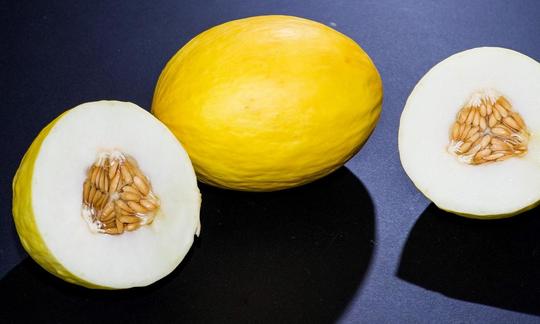

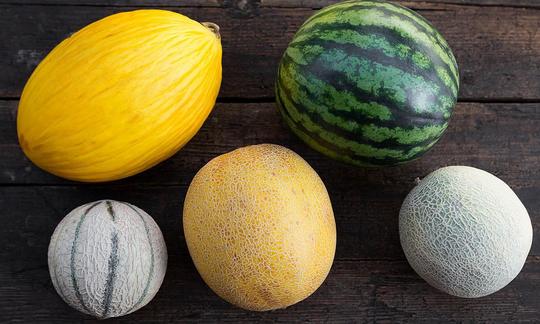

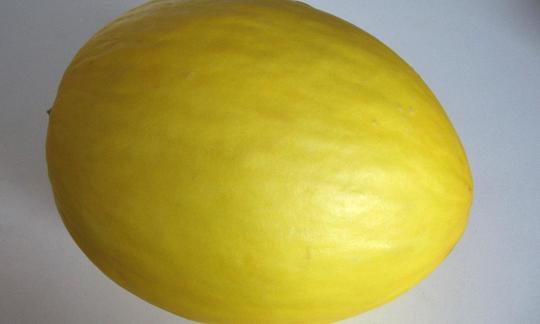

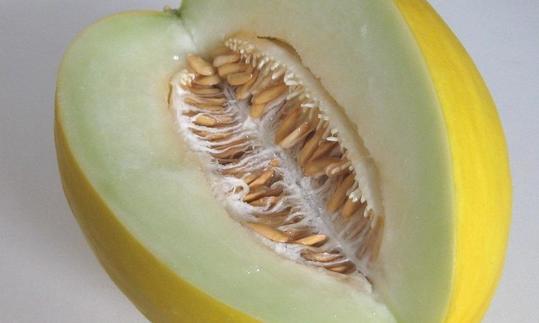

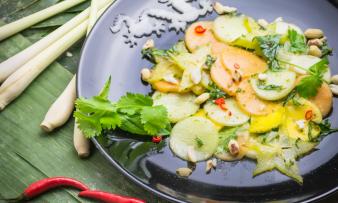





Comments